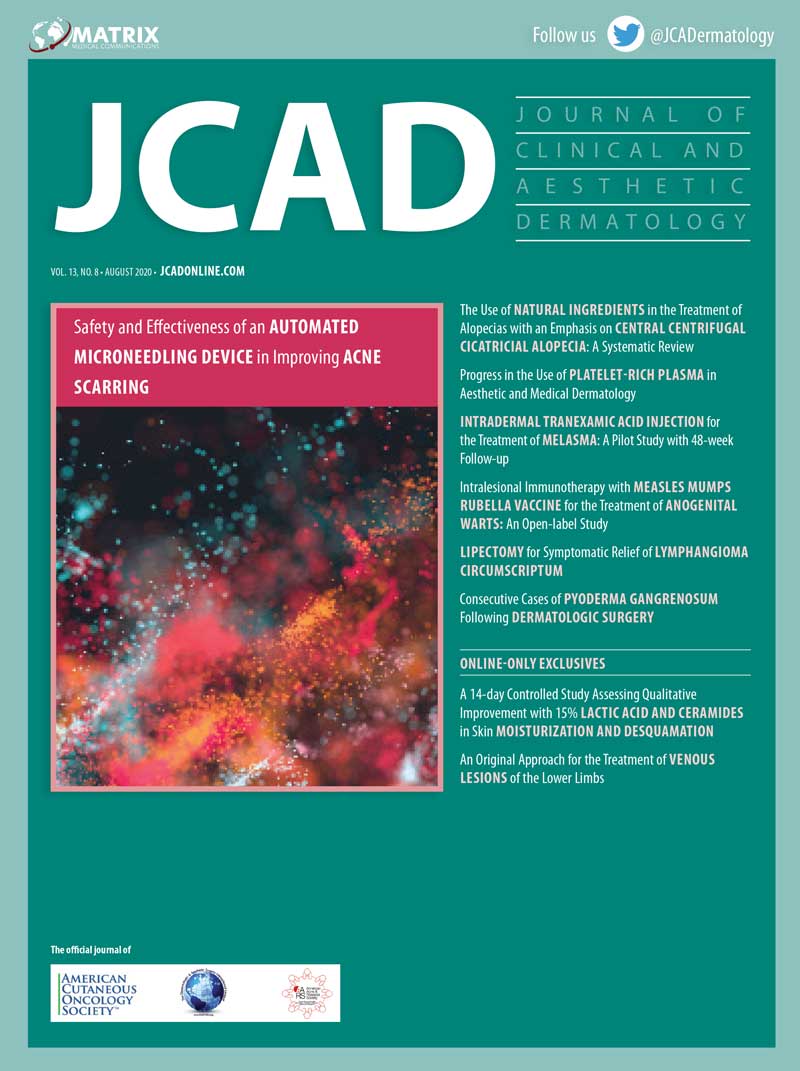Vol. 13, No. 8 • August 2020
 Dear Colleagues:
Dear Colleagues:
Welcome to the August 2020 issue of The Journal of Clinical and Aesthetic Dermatology. We begin the issue with original research from Freiherr von Dalwig-Nolda and Ablon, in which the authors assessed the effectiveness of the amiea med (amiea med, MT.DERM GmbH, Berlin, Germany) automated microneedling device for reducing facial atrophic acne scars. Here, 30 healthy male and female participants, aged 18 to 65 years, with signs of facial atrophic acne scarring underwent four microneedling sessions 30 days apart. Subjects were assessed at baseline and three months after the last treatment, at which time the authors reported facial acne scars had improved by 0.91 of a grade, according to the Goodman and Baron Grading Scale, with rolling scars showing the greatest improvement.
Next, we present a review article from Ezekwe et al, in which the authors reviewed clinical studies evaluating the use of natural ingredients in the treatment of central centrifugal cicatricial alopecia (CCCA). Potential natural ingredients for the treatment of CCCA included azelaic acid, peppermint oil, pumpkin seed oil, garlic supplements/shampoo, black castor oil, jojoba oil, argan oil, olive oil, horsetail plant oil, lavender oil, coconut oil, chamomile oil, thyme oil, tea tree oil, sulfur oil, menthol, and rosemary oil. The authors identified eight studies that evaluated natural CCCA treatments, but found no randomized, controlled studies evaluating the use of these ingredients.
After this, in a review article from Lin et al, the authors review the current literature on the use of platelet-rich plasma (PRP) for skin rejuvenation, androgenic alopecia, alopecia areata, chronic vitiligo, melasma, inflammatory nail disorders, and psoriasis. Upon completion of their review, the authors concluded that more detailed studies are necessary to standardize PRP preparation and optimize treatment methods in order to further improve its usefulness.
Following this, in an original research article from Lueangarun et al, the authors share the results of their pilot study, which evaluated the efficacy of 4mg/mL intradermal tranexamic acid (TA) injections for the treatment of melasma. Five female patients with melasma participated in the 48-week study, receiving 4-mg/mL intradermal TA injections on the face every two weeks for seven sessions and a sunscreen prescription. At 16 weeks, there was a significant decrease in Melasma Area Severity Index (mMASI) score and melanin index, without a statistically significant improvement in mMASI at 48 weeks. Melasma recurrence was observed in 60 percent of the participants, with higher mMASI scores recorded, but the severity remained less than at baseline.
Next, Sharma et al share the results of their original research, which evaluated the measles, mumps, and rubella (MMR) vaccine for the treatment of anogenital warts (AGWs). In this hospital-based, longitudinal study that included 35 patients with AGWs, 0.5mL of the MMR vaccine after reconstitution with distilled water was injected intradermally into each patient’s single largest wart. Injections were given every three weeks until a maximum of three injections was achieved. On average, a 42.4-percent improvement was observed in the first three weeks after administering the MMR vaccine, which increased to 75.8 percent after the second vaccine at six weeks and nearly 98 percent after the last vaccine at nine weeks.
After this, Shrestha et al present two cases of lymphangioma circumscriptum (LC) that demonstrated characteristics of half-and-half lacunae or hypopyon sign in dermoscopy. The first case discussed was that of a 19-year-old female patient with localized lymphangioma since childhood, presenting with continuous oozing of blood and fluid from the lesion. The second patient presented with extensive disease with verrucous growths and clear vesicles over the right chest wall. A lipectomy was performed on both patients to destroy subcutaneous connecting lymphatics, which caused significant symptomatic improvement in oozing of blood and fluid, which had been present since childhood in both patients.
Following this, Wanner et al present the case of a patient who experienced two episodes of pyoderma gangrenosum (PG) following consecutive dermatologic surgeries to the left hand. The initial PG ulcerations occurred simultaneously following Mohs surgery and a standard elliptical excision. Five months later, the patient’s PG recurred after Mohs surgery. A 30-day steroid taper, clobetasol cream, and dapsone were prescribed, with complete resolution of her ulcerations.
Our online-only exclusive articles this month include original research from Draelos et al, in which the authors conducted a randomized, single-center, controlled, evaluator-blinded, within-subject comparison of a lactic acid/ceramide lotion versus no treatment. In addition, Palotta et al share results from their study evaluating a treatment method for small- and medium-sized varicose veins and phlebological imperfections of the lower limbs.
We hope you enjoy this issue of JCAD. As always, we welcome your feedback and submissions.
With regards,
James Q. Del Rosso, DO, FAOCD—Editor-in-Chief, Clinical Dermatology

